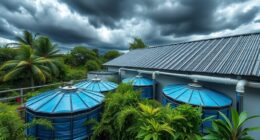In 2011, Fukushima’s response highlighted the importance of swift containment efforts, effective communication, and constantly updating emergency protocols. When the earthquake and tsunami overwhelmed safety systems, responders injected seawater, deployed portable generators, and monitored radiation closely to prevent further catastrophe. The disaster taught essential lessons about preparedness, safety gaps, and the need for ongoing training. If you keep exploring, you’ll discover how these lessons shape nuclear safety improvements worldwide.
Key Takeaways
- Emergency protocols included swift seawater injection and portable generator deployment to manage core cooling failures.
- Continuous radiation monitoring guided evacuation zones and containment strategies during the crisis.
- Clear communication among responders ensured coordinated efforts and effective information flow between teams and agencies.
- Lessons from Fukushima highlighted the need for improved safety measures, flexible protocols, and resilient emergency planning.
- Ongoing training and system upgrades focus on faster, more effective responses to future nuclear incidents.

The Fukushima Daiichi nuclear disaster occurred in March 2011 when a massive earthquake and tsunami overwhelmed Japan’s northeastern coast, knocking out power supplies and cooling systems at the plant. As a result, the operators faced an urgent crisis to contain the release of radiation and prevent further catastrophe. Your role in such a situation centers on understanding how emergency protocols are designed to manage these extreme conditions. When the cooling systems failed, the immediate concern was to establish radiation containment to protect both workers and the surrounding environment. This involved quickly deploying measures like seawater injection and deploying portable generators to restore cooling functions. The goal was to limit the spread of radioactive materials, which required swift, coordinated actions grounded in well-practiced emergency protocols. These protocols are crucial because they provide clear steps for managing complex, high-pressure scenarios, ensuring that responses are effective and minimize risks. Effective disaster response plans also incorporate continuous improvement based on past experiences, which was vital after Fukushima.
You need to recognize that radiation containment isn’t just about physical barriers but also involves continuous monitoring and strategic decision-making. During the crisis, workers used specialized equipment to observe radiation levels and adjust their actions accordingly. This constant surveillance helped prevent uncontrolled releases and guided decisions on evacuation zones and protective measures. The importance of emergency protocols becomes evident here—they serve as a blueprint that directs every step, from initial assessment to long-term containment strategies. Without them, responders might act chaotically, increasing the risk of widespread contamination. The protocols also emphasize communication, ensuring that all personnel are aware of their roles and that information flows efficiently between onsite teams and external agencies. This coordinated effort helps contain radiation more effectively and reduces the likelihood of further accidents.
In the aftermath, lessons learned highlight the importance of refining these protocols based on real-world experience. You realize that preparedness, training, and adaptable strategies are essential to handling unexpected situations. The Fukushima incident exposed gaps in safety measures and underscored the need for robust emergency protocols that can be executed under extreme stress. Ongoing improvements focus on enhancing radiation containment methods, such as better containment vessels and improved filtration systems, alongside detailed emergency response plans. As someone involved in disaster management, you understand that these lessons are invaluable for future safety measures. They remind you that proactive planning, rigorous training, and resilient protocols are your best defenses against nuclear emergencies, ensuring that if history repeats itself, responses will be faster, more coordinated, and ultimately more effective.
Frequently Asked Questions
What Emergency Protocols Were in Place Before the Disaster?
You had evacuation procedures and safety drills in place before the disaster, designed to prepare staff and local residents for emergencies. These protocols aimed to guarantee swift evacuation and minimize risks during a crisis. Regular safety drills helped reinforce response actions, but the Fukushima disaster revealed gaps in preparedness. Despite these measures, unforeseen challenges tested the effectiveness of your emergency protocols and highlighted areas needing improvement.
How Did International Agencies Assist Japan During the Crisis?
During the crisis, international agencies provided essential aid by coordinating efforts through organizations like the IAEA and WHO. They supplied technical expertise, emergency supplies, and radiation monitoring equipment. Your team benefited from swift agency collaboration that helped manage radiation risks, assist displaced populations, and support Japan’s response efforts. This coordinated international aid ensured a more effective response, highlighting the significance of global cooperation during nuclear emergencies.
What Were the Long-Term Health Effects on Local Residents?
You might think the long-term health effects are just about radiation exposure, but mental health issues hit just as hard. Residents face anxiety, depression, and stress from ongoing fears and displacement. Ironically, while radiation levels have decreased, the psychological scars remain, showing that the true aftermath isn’t just physical but deeply emotional. Your community’s resilience is tested, highlighting that health isn’t only about radiation but also the mind’s healing.
How Has Fukushima’s Environment Recovered Since 2011?
Since 2011, Fukushima’s environment has made progress thanks to radiation cleanup efforts and ecological recovery initiatives. You’ll notice reduced radiation levels in some areas, allowing for safer visits and resumed farming activities. However, certain zones still face contamination challenges, and natural ecosystems are gradually rebounding. Continuous monitoring and cleanup work help support ongoing ecological recovery, but full environmental restoration remains a long-term process.
What Technological Improvements Have Been Implemented Post-Disaster?
After Fukushima, you’ll see major tech upgrades like advanced robotics and real-time monitoring systems. For example, robots now inspect damaged reactor cores, reducing human risk. Real-time sensors continuously track radiation levels, enabling quick responses to potential issues. These improvements help prevent further accidents, streamline cleanup, and guarantee safer nuclear operations. You benefit from increased safety measures, making nuclear energy more reliable and secure for the future.
Conclusion
As you reflect on Fukushima Daiichi’s events, it’s striking how the disaster’s lessons emerged amidst chaos, almost as if fate intertwined human error and nature’s fury. The accident revealed vulnerabilities you might overlook, reminding you that preparedness often hinges on unforeseen coincidences. In understanding these intertwined moments, you see that resilience isn’t just technical—it’s a mindful dance with the unpredictable, urging you to learn, adapt, and respect the delicate balance between humanity and nature.










